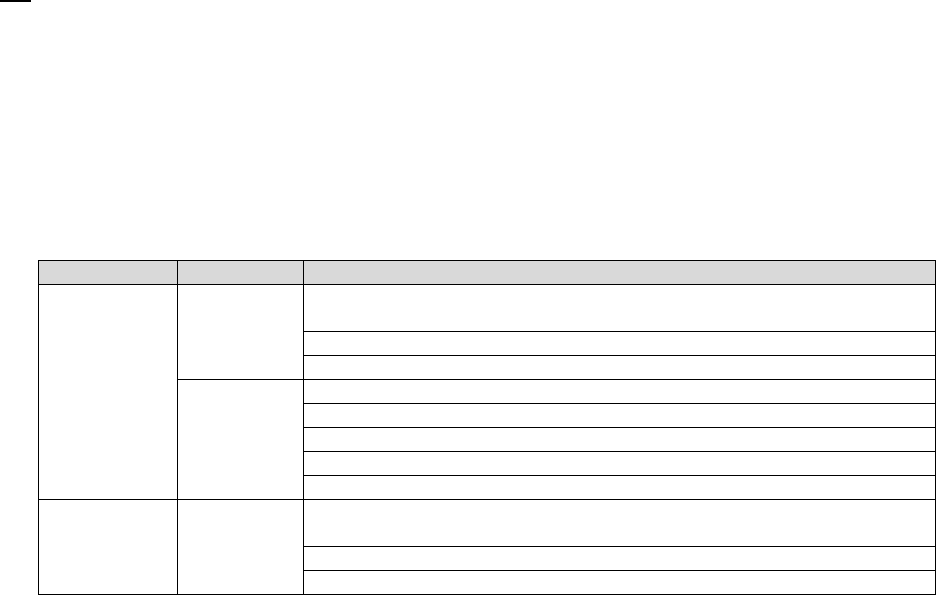
Misawa AB, JAPAN
Drinking Water
Consumer Confidence Report (CCR)
2021
`
CONTENTS:
1. Acronyms/terms used in this report
2. What is a CCR?
3. Where does Misawa drinking water come from?
4. What types of contaminants may be in my drinking water and why?
5. Is our drinking water safe?
6. How is our drinking water treated?
7. How often is Misawa's drinking water tested?
8. What is in our drinking water?
9. Where can we get more information?
1. ACRONYMS AND TERMS USED IN THIS REPORT: The table below explains the acronyms, terms, and
units of measure used in this CCR:
Table 1. Acronym/Term List
Unit Descriptions
Term
Definition
mg/L
Milligrams per liter
ppm
Parts per million
pCi/L
Picocuries per liter
ppt
Parts per trillion
Important Drinking Water Definitions
Term
Definition
Action
Level
Concentration of a contaminant which if exceeded triggers treatment or other requirements which a water
system must follow.
MCLG
Maximum Contaminant Level Goal: The level of a contaminant in drinking water below which there is no
known or expected risk to health. MCLGs allow for a margin of safety.
MCL
Maximum Contaminant Level: The highest level of a contaminant that is allowed in drinking water. MCLs
are set as close to the MCLGs as feasible using the best available treatment technology.
MRDL
Maximum Residual Disinfectant Level: The highest level of a disinfectant allowed in drinking water. There
is convincing evidence that addition of a disinfectant is necessary for control of microbial contaminants.
MRDLG
Maximum Residual Disinfectant Level Goal: The level of a drinking water disinfectant below which there
is no known or expected risk to health. MRDLGs do not reflect the benefits of the use of disinfectants to
control microbial contaminants.

2. WHAT IS A CCR?
The U.S. Environmental Protection Agency (EPA) and Japan Environmental Governing Standards (JEGS) requires
community water systems to provide annual drinking water quality reports to their customers. These reports, known
as Consumer Confidence Reports (CCRs), enable people to make practical, knowledgeable decisions about their
health and their environment.
3. WHERE DOES MISAWA’s DRINKING WATER COME FROM?
The Air Force maintains three separate drinking water systems on Misawa AB (Main Base, North Area and Security
Hill), and two separate water systems at the Draughon Range (Gate Area and Tower Area). The Main Base receives
water from seven ground water wells and Lake Anenuma. The North Area receives its water from four north area
ground water wells. Security Hill receives its water from two deep wells. Draughon Range contains two systems:
the Air Force Range Office and surrounding buildings receive water from one ground water well, while the gate area
receives its water from the City of Misawa. The City of Misawa receives its water from ground water wells.
Bioenvironmental Engineering conducts water sampling for Air Force owned and operated systems. City water
quality is monitored by the city of Misawa.
4. WHAT TYPES OF CONTAMINANTS MAY BE IN MY DRINKING WATER AND WHY?
a. The sources of drinking water (both tap water and bottled water) include rivers, lakes, streams, ponds,
reservoirs, springs, and wells. As water travels over land surfaces or through the ground it dissolves naturally
occurring minerals, radioactive material, and substances resulting from the presence of animal or human activity.
Contaminants that may be present in source water include:
Microbial contaminants--such as viruses and bacteria, which may come from sewage treatment plants,
septic systems, agricultural livestock operations, and wildlife.
Inorganic contaminants--such as salts and metals, which can be naturally-occurring or result from urban
storm water runoff, industrial or domestic wastewater discharges, oil and gas production, mining, and
farming.
Pesticides and herbicides--may come from a variety of sources such as agriculture, storm water runoff, and
residences.
Organic chemical contaminants--including synthetic and volatile organic chemicals, which are byproducts
of industrial processes and petroleum production. Organic chemicals can also come from gas stations,
urban storm water runoff, and septic systems.
Radioactive contaminants--may be naturally occurring or manmade.
b. In order to ensure tap water is safe to drink, the Department of Defense prescribes regulations limiting the
amount of certain contaminants in water provided by public water systems. These limits are the same as those
established by the EPA for drinking water in the US. Drinking water, including bottled water, may reasonably be
Range
The range of the highest and lowest analytical values of a reported contaminant. For example, the range of
reported analytical detections for an unregulated contaminant may be 10.1 ppm (lowest value measured in
year) to 13.4 ppm (highest value measured in year). EPA requires this range to be reported.
Treatment
Technique
A required process intended to reduce the level of a contaminant in drinking water.
Acronym Explanation
Acronym
Explanation
AB
Air Base
CCR
Consumer Confidence Report
EPA
Environmental Protection Agency
N/A
Not Applicable
POL
Petroleum, Oils, and Lubricants

expected to contain at least small amounts of some contaminants. The presence of contaminants does not
necessarily indicate that water poses a health risk.
c. Some people may be more vulnerable to contaminants in drinking water than the general population.
Immunocompromised persons such as persons with cancer undergoing chemotherapy, persons who have undergone
organ transplants, people with HIV-AIDS or other immune system disorders, some elderly, and infants can be
particularly at risk of infections. These people should seek advice about drinking water from their health care
providers. For more information about contaminants and potential health effects, or to receive a copy of the U.S.
Environmental Protection Agency (EPA) and the U.S. Centers for Disease Control (CDC) guidelines on appropriate
means to lessen the risk of infection by Cryptosporidium and microbiological contaminants call the EPA Safe
Drinking Water Hotline at (1-800-426-4791).
d. Nitrate in drinking water at levels above 10 ppm is a health risk for infants of less than six months of age.
High nitrate levels in drinking water can cause blue baby syndrome. Nitrate levels may rise quickly for short
periods of time because of rainfall or agricultural activity. The highest levels of nitrate detected at Misawa Air Base
are 3.0 ppm. If you are caring for an infant you should ask advice from your health care provider.
e. The 35 CES is responsible for providing high quality drinking water to the occupants and workers of Misawa
Air Base. Lead in drinking water is primarily from materials and components associated with service lines and
home plumbing. For this reason, Bioenvironmental Engineering samples for lead contamination. During the last
sample events in 2021 for Main Base, North Area and Security Hill, all results were below the EPA action level. If
present, elevated levels of lead can cause serious health problems, especially for pregnant women and young
children. If you are concerned about lead in your drinking water, you may wish to have your water tested.
Information on lead in drinking water, testing methods, and steps you can take to minimize exposure is available at
http://www.epa.gov/safewater/lead/.
5. IS OUR DRINKING WATER SAFE?
Yes. We receive high-quality water that meets the same standards as drinking water in the US. Civil Engineering
provides constant treatment and maintenance of our water distribution system; while, Bioenvironmental Engineering
Flight ensures water quality by collecting samples and analyzing our potable water.
6. HOW IS OUR DRINKING WATER TREATED?
Treatment systems are operated in a manner that ensures appropriate chemical concentrations are maintained
throughout the distribution system. Table 2 below describes the treatment process for each location on the
installation.
Table 2. Water Treatment
Location
Source
Water Treatment Processes
Main Base
Well Water
Sand sedimentation to remove suspended matter such as sand, dirt, rust,
loose scale, clay or organic material from the water.
Chlorination to disinfect/prevent distribution system contamination
Fluoridation to prevent cavities in children
Lake Water
Activated carbon filtration to absorb chemicals
Coagulation/flocculation/sedimentation to remove algae/large particles
Sand filter to remove particles
Chlorination to disinfect/prevent distribution system contamination
Fluoridation to prevent cavities in children
North Area
Well Water
Sand sedimentation to remove suspended matter such as sand, dirt, rust,
loose scale, clay or organic material from the water.
Chlorination to disinfect/prevent distribution system contamination
Fluoridation to prevent cavities in children

Security Hill
Well Water
Sand sedimentation to remove suspended matter such as sand, dirt, rust,
loose scale, clay or organic material from the water.
Chlorination to disinfect/prevent distribution system contamination
Draughon
Range Tower
Area
Well Water
Chlorination to disinfect/prevent distribution system contamination
Draughon
Range Gate
Area
City Water
Chlorination to disinfect/prevent distribution system contamination
Sand Stripping to remove suspended matter such sand, dirt, rust, loose,
scale, clay or organic material from the water.
7. HOW OFTEN IS MISAWA’s DRINKING WATER TESTED?
In compliance with Air Force and Department of Defense regulations, the Bioenvironmental Engineering Flight
monitors for more than 100 possible substances in Misawa’s drinking water at different intervals. Table 3 below
identifies the sampling they conduct.
Table 3. Contaminant Groups and Monitoring Frequencies
Contaminant Group
Examples
Monitoring Frequency
Biological Contaminants
Coliform bacteria
All water systems - Monthly
Inorganic Contaminants
Metals (e.g. lead, copper,
selenium, arsenic, mercury,
nickel)
Main Base Lake Water - Annually
Main Base Well Water - Once every three years
North Area - Once every three years
Security Hill - Once every three years
Nitrate, Nitrite, Total Nitrate
and Nitrite
Main Base Lake Water Annually
Main Base Well Water - Annually
North Area - Annually
Security Hill – Annually
Volatile Organic
Compounds
Benzene, Trichloroethylene,
Carbon Tetrachloride, etc.
Main Base Lake Water - Once every three years
Main Base Well Water - Quarterly
North Area - Once every three years
Security Hill - Once every three years
Synthetic Organic
Compounds
Pesticides, Herbicides, PCBs
Main Base Lake Water - two consecutive quarters
every three years
Main Base Well Water - two consecutive quarters
every three years
North Area - Once every three years
Security Hill - Once every three years
Lead & Copper From
Plumbing Materials
Lead, Copper
Main Base, North Area, Security Hill - Once every
three years
Radiological Compounds
Gross Alpha and Beta, Radium
226
Main Base - Every four years (distribution system)
North Area – Every four years (distribution
system)
Security Hill - Not required
Beta Particle & Photon Activity
Main Base - Every nine years (distribution system)
North Area – Every nine years (distribution
system)
Security Hill - Not required
Disinfectant By-Products
Trichloromethanes,
Haloacetic Acids (HAA5)
Main Base - Quarterly (distribution system)
North Area - Annually
Security Hill - Annually
Total Organic Carbon,
Alkalinity
Main Base - Quarterly

Note 1 : It was determined the two water systems at Draughon Range is non-public water system. Therefore, the monitoring
requirements listed in the 2020 Japan Environmental Governing Standards (JEGS) do not apply, except for total coliforms and
disinfectant residual.
Note 2 : Frequency of sampling for PFAS at Main Base and Draughon Range Tower Area have changed from “Quarterly” to
“Every two years” after four consecutive samples have shown levels below the EPA lifetime health advisory(HA).
8. WHAT IS IN OUR DRINKING WATER?
The potable water of Misawa AB meets all the EPA and Air Force health standards. The vast majority of regulated
substances were not found in the water of Misawa AB. The contaminants presented in the following tables are
organized by the respective water distribution system. Only contaminants detected are reported, results below the
analytical detection limit are not included. Some contaminants are not tested annually. In these cases, the most
current results are reported even though the actual sample may have been collected in a previous year. The presence
of contaminants in the water does not necessarily indicate a health risk.
Table 4. Detected Contaminants for Main Base Distribution System
Non Regulated
Compounds/Emerging
Contaminants
PFAS (per- and polyfluoroalkyl
substances)
Main Base – Every two years
North Area – Every three years
Security Hill – Every three years
Draughon Range Tower Area –Every two years
Draughon Range Gate Area – Every three years
Contaminant
MCLG
MCL
Highest
Level
Sample
Date
Above
MCL?
Typical Source
Health Effects Language
Inorganic Contaminants
Nitrate
10.0
mg/L
10.0
mg/L
3.0
mg/L
2021
No
Runoff from fertilizer
use; leaching from
septic tanks, sewage;
erosion of natural
deposits
Infants below the age of six
months who drink water containing
nitrate in excess of the MCL could
become seriously ill and, if
untreated, may die. Symptoms
include shortness of breath and
blue baby syndrome.
Fluoride
4.0
mg/L
4.0
mg/L
0.7
mg/L
2021
No
Water additive which
promotes strong
teeth; erosion of
natural deposits;
discharge from
fertilizer and
aluminum factories
Some people who drink water
containing fluoride in excess of
the MCL over many years could
get bone disease, including pain
and tenderness of the bones.
Fluoride in drinking water at half
the MCL or more may cause
mottling of children's teeth,
usually in children less than nine
years old. Mottling, also known
as dental fluorosis, may include
brown staining and/or pitting of
the teeth, and occurs only in
developing teeth before they
erupt from the gums.
Arsenic
zero
0.01
mg/L
0.0015
mg/L
2020
No
Erosion of natural
deposits; runoff from
orchards; glass &
electronics
production wastes
Some people who drink water
containing arsenic in excess of
the MCL over many years could
experience skin damage or
problems with their circulatory

system, and may have an
increased risk of getting cancer.
Barium
2.0
mg/L
2.0
mg/L
0.0053
mg/L
2021
No
Discharge of drilling
waste; discharge
from metal refineries;
erosion of natural
deposits
Some people who drink water
containing barium in excess of
the MCL over many years could
experience an increase in their
blood pressure.
Chromium, Total
0.1
mg/L
0.1
mg/L
0.0015
g/L
2020
No
Discharge from steel
and pulp mills;
erosion of natural
deposits
Some people who use water
containing chromium well in
excess of the MCL over many
years could experience allergic
dermatitis.
Sodium
No
MCLG
200
mg/L
25
mg/L
2021
No
Discharge from
mines; discharge
from petroleum
refineries
Lead
zero
Action
Level
0.015
mg/L
0.0014
mg/L
2021
No
Corrosion of
household plumbing
systems; erosion of
natural deposits
Infants and children who drink
water containing lead in excess of
the action level could experience
delays in their physical or mental
development. Children could show
slight deficits in attention span and
learning abilities. Adults who drink
this water over many years could
develop kidney problems or high
blood pressure.
Copper
1.3
mg/L
Action
Level
1.3
mg/L
0.12
mg/L
2021
No
Corrosion of
household plumbing
systems; erosion of
natural deposits
Copper is an essential nutrient,
but some people who drink water
containing copper in excess of
the action level over a relatively
short amount of time could
experience gastrointestinal
distress. Some people who drink
water containing copper in
excess of the action level over
many years could suffer liver or
kidney damage. People with
Wilson's disease should consult
their personal doctor.
Volatile Organic Compounds
Tetrachloroethylene
zero
0.005
mg/L
0.00087
mg/L
2021
No
Discharge from
factories and dry
cleaners
Some people who drink water
containing tetrachloroethylene in
excess of the MCL over many
years could have problems with
their liver, and may have an
increased risk of getting cancer.
Trichloroethylene
zero
0.005
mg/L
0.004
mg/L
2021
No
Discharge from metal
degreasing sites and
other factories
Some people who drink water
containing trichloroethylene in
excess of the MCL over many
years could experience problems
with their liver and may have an
increased risk of getting cancer.

Disinfectant Byproducts
Total
Trihalomethanes
(TTHMs)
(Veterinary Clinic)
See
Note 1
0.08
mg/L
0.0285
mg/L
2021
No
Byproduct of
drinking water
disinfection
Some people who drink water
containing trihalomethanes in
excess of the MCL over many
years may experience problems
with their liver, kidneys, or
central nervous systems, and may
have an increased risk of getting
cancer.
Haloacetic Acids
(Veterinary Clinic)
See
Note 1
0.06
mg/L
0.0096
mg/L
2021
No
Byproduct of
drinking water
disinfection
Some people who drink water
containing haloacetic acids in
excess of the MCL over many
years may have an increased risk
of getting cancer.
Total
Trihalomethanes
(POL)
See
Note 1
0.08
mg/L
0.0235
mg/L
2021
No
Byproduct of
drinking water
disinfection
Some people who drink water
containing trihalomethanes in
excess of the MCL over many
years may experience problems
with their liver, kidneys, or
central nervous systems, and may
have an increased risk of getting
cancer.
Haloacetic Acids
(POL)
See
Note 1
0.06
mg/L
0.0072
mg/L
2021
No
Byproduct of
drinking water
disinfection
Some people who drink water
containing haloacetic acids in
excess of the MCL over many
years may have an increased risk
of getting cancer.
Total Organic
Carbon (Source)
See
Note 2
N/A
1.973
mg/L
2021
No
Organic contaminants
(natural organic
substances,
insecticides,
herbicides, and other
agricultural
chemicals)
Total organic carbon (TOC) has
no health effects. However, total
organic carbon provides a
medium for the formation of
disinfection by products. These
byproducts include
trihalomethanes (TTHMs) and
haloacetic acids (HAA5s).
Drinking water containing these
byproducts in excess of the MCL
may lead to adverse health
effects, liver or kidney problems,
or nervous system effects, and
may lead to an increased risk of
getting cancer.
Alkalinity (Source)
See
Note 2
N/A
61.43
mg/L
2021
No
Most alkalinity in
water comes from
calcium carbonate
leached from rocks
and soil.
Total Organic
Carbon (Treated)
See
Note 2
N/A
0.896
mg/L
2021
No
Organic contaminants
(natural organic
substances,
insecticides,
herbicides, and other
Total organic carbon (TOC) has
no health effects. However, total
organic carbon provides a
medium for the formation of

Note:
1. The reported reading is the running annual average of quarterly averages of all samples taken in the distribution system.
Although there is no collective MCLG for this contaminant group, there are MCLGs for some of the individual contaminants:
• Trihalomethanes: bromodichloromethane (0 mg/L); bromoform (0 mg/L); dibromochloromethane (0.06 mg/L):
chloroform (0.07 mg/L).
• Haloacetic acids: dichloroacetic acid (0 mg/L); trichloroacetic acid (0.02 mg/L); monochloroacetic acid (0.07 mg/L).
Bromoacetic acid and dibromoacetic acid are regulated with this group but have no MCLGs.
2. Total organic carbon (TOC), a form of disinfection byproducts precursors has no health effects. However, total organic carbon
provides a medium for the formation of disinfection byproducts. These byproducts include trihalomethanes (TTHMs) and
haloacetic acids (HAA5s). Drinking water containing these byproducts in excess of the MCL may lead to adverse health effects,
liver, or kidney problems, or nervous system effects, and may lead to an increased risk of getting cancer. IAW 2020 JEGS,
systems that use conventional filtration treatment (MB) must monitor each treatment plant water source for TOC on a monthly
basis. Samples must be taken from the source water prior to treatment and the treated water not later than the point of combined
filter effluent turbidity monitoring. Source water alkalinity must also be monitored at the same time. Neither MCLG nor MCL
are outlined in the regulation.
Table 5. Detected Contaminants for North Area Distribution System
agricultural
chemicals)
disinfection byproducts. These
byproducts include
trihalomethanes (THMs) and
haloacetic acids (HAA5s).
Drinking water containing these
byproducts in excess of the MCL
may lead to adverse health
effects, liver or kidney problems,
or nervous system effects, and
may lead to an increased risk of
getting cancer.
Alkalinity (Treated)
See
Note 2
N/A
47.43
mg/L
2021
No
Most alkalinity in
water comes from
calcium carbonate
leached from rocks
and soil
Contaminant
MCLG
MCL
Highest
Level
Sample
Date
Above
MCL?
Typical Contaminant
Source
Health Effects Language
Inorganic Contaminants
Arsenic
zero
0.01
mg/L
0.0035
mg/L
2019
No
Erosion of natural deposits;
runoff from orchards; glass
& electronics production
wastes
Some people who drink
water containing arsenic
in excess of the MCL
over many years could
experience skin damage
or problems with their
circulatory system, and
may have an increased
risk of getting cancer.
Barium
2.0
mg/L
2.0
mg/L
0.002
mg/L
2019
No
Discharge of drilling
waste; discharge from
metal refineries; erosion of
natural deposits
Some people who drink
water containing barium
in excess of the MCL
over many years could
experience an increase in
their blood pressure.

Fluoride
4.0
mg/L
4.0
mg/L
0.7
mg/L
2019
No
Water additive which
promotes strong teeth;
erosion of natural deposits;
discharge from fertilizer
and aluminum factories
Some people who drink
water containing fluoride
in excess of the MCL
over many years could
get bone disease,
including pain and
tenderness of the bones.
Fluoride in drinking water
at half the MCL or more
may cause mottling of
children's teeth, usually in
children less than nine
years old. Mottling, also
known as dental fluorosis,
may include brown
staining and/or pitting of
the teeth, and occurs only
in developing teeth before
they erupt from the gums.
Nickel
0.1
mg/L
0.1
mg/L
0.0011
mg/L
2019
No
Leaching from metals in
contact with drinking-
water, such as pipes and
fittings. However, nickel
may also be present in
some groundwaters as a
consequence of dissolution
from nickel ore-bearing
rocks.
Sodium
No
MCLG
200.0
mg/L
11 mg/L
2019
No
Discharge from mines;
discharge from petroleum
refineries
Copper
1.3
mg/L
Action
Level
1.3
mg/L
0.0096
mg/L
2021
No
Corrosion of household
plumbing systems; erosion
of natural deposits
Copper is an essential
nutrient, but some people
who drink water
containing copper in
excess of the action level
over a relatively short
amount of time could
experience
gastrointestinal distress.
Some people who drink
water containing copper
in excess of the action
level over many years
could suffer liver or
kidney damage. People
with Wilson's disease
should consult their
personal doctor.
Disinfectant Byproducts
Total
Trihalomethanes
(TTHMs)
See
Note 1
0.08
mg/L
0.0028
mg/L
2021
No
Byproduct of drinking
water disinfection
Some people who drink
water containing
trihalomethanes in excess
of the MCL over many

Note:
1. The reported reading is the running annual average of quarterly averages of all samples taken in the distribution system.
Although there is no collective MCLG for this contaminant group, there are MCLGs for some of the individual contaminants:
• Trihalomethanes: bromodichloromethane (0 mg/L); bromoform (0 mg/L); dibromochloromethane (0.06 mg/L):
chloroform (0.07 mg/L).
• Haloacetic acids: dichloroacetic acid (0 mg/L); trichloroacetic acid (0.02 mg/L); monochloroacetic acid (0.07 mg/L).
Bromoacetic acid and dibromoacetic acid are regulated with this group but have no MCLGs
Table 6. Detected Contaminants for Security Hill Distribution System
Contaminant
MCLG
MCL
Highest
Detected
Level
Sample
Date
Above MCL?
Typical Source
Health Effects Language
Inorganic Contaminants
Sodium
No
MCLG
200.0
mg/L
22 mg/L
2021
No
Discharge from
mines; discharge from
petroleum refineries
Lead
Note
1
zero
0.015
mg/L
0.0024 mg/L
2021
No
Corrosion of
household plumbing
systems; erosion of
natural deposits
Infants and children who
drink water containing
lead in excess of the
action level could
experience delays in their
physical or mental
development. Children
could show slight deficits
in attention span and
learning abilities. Adults
who drink this water over
many years could
develop kidney problems
or high blood pressure.
Copper
Note
1
1.3
mg/L
Action
Level
1.3
mg/L
0.00220 mg/L
2021
No
Corrosion of
household plumbing
systems; erosion of
natural deposits
Copper is an essential
nutrient, but some people
who drink water
containing copper in
excess of the action level
over a relatively short
amount of time could
experience
gastrointestinal distress.
Some people who drink
water containing copper
in excess of the action
level over many years
could suffer liver or
kidney damage. People
years may experience
problems with their liver,
kidneys, or central
nervous systems, and may
have an increased risk of
getting cancer.

with Wilson's disease
should consult their
personal doctor.
Disinfectant Byproducts
Total
Trihalomethanes
(TTHMs)
See
Note 2
0.08
mg/L
0.0388 mg/L
2021
No
Byproduct of drinking
water disinfection
Some people who drink
water containing
trihalomethanes in excess
of the MCL over many
years may experience
problems with their liver,
kidneys, or central
nervous systems, and
may have an increased
risk of getting cancer.
Haloacetic
Acids
See
Note 2
0.06
mg/L
0.0072 mg/L
2021
No
Byproduct of drinking
water disinfection
Some people who drink
water containing
haloacetic acids in excess
of the MCL over many
years may have an
increased risk of getting
cancer.
Note:
1. Lead and copper are regulated by a treatment technique that requires systems to control the corrosiveness of their water. If
more than 10% of tap water samples exceed the action level, water systems must take additional steps. For copper, the action
level is 1.3 mg/L, and for lead is 0.015 mg/L.
2. The reported reading is the running annual average of quarterly averages of all samples taken in the distribution system.
Although there is no collective MCLG for this contaminant group, there are MCLGs for some of the individual contaminants:
• Trihalomethanes: bromodichloromethane (0 mg/L); bromoform (0 mg/L); dibromochloromethane (0.06 mg/L):
chloroform (0.07 mg/L).
• Haloacetic acids: dichloroacetic acid (0 mg/L); trichloroacetic acid (0.02 mg/L); monochloroacetic acid (0.07 mg/L).
Bromoacetic acid and dibromoacetic acid are regulated with this group but have no MCLGs.
Table 7. Perfluorooctane sulfonate (PFOS)/Perfluorooctanoic acid (PFOA) (Emerging Contaminants)
Main Base Water System (Drinking Water)
Sample
Timeframe
Contaminant
MCLG
MCL
Detected Level
Above
MCL?
EPA
Health
Advisory
Typical Source
Aug 20 –
May 21
PFAS
(PFOS + PFOA)
N/A
N/A
Lowest
25.0
N/A
70 ppt
Runoff from firefighting
foam/other every day products
Highest
35.1
Draughon Range Tower Area System (Drinking Water)
Sample
Timeframe
Contaminant
MCLG
MCL
Detected Level
Above
MCL?
EPA
Health
Advisory
Typical Source
Jul 20 – May
21
PFAS
(PFOS + PFOA)
N/A
N/A
Lowest
15.3 ppt
N/A
70 ppt
Runoff from firefighting
foam/other every day products
Highest
31.1 ppt

Note: Results for Security Hill and North Base systems were below the limit of detection.
Water System consists of wells, treatment facilities and distribution points
Background: PFOS and PFOA have been used for decades in many commercial products such as stain resistant carpeting,
firefighting foam, nonstick cookware, fabric coatings and some food packaging. The EPA continues to develop the science on
the general public health effects and to further evaluate whether these contaminants should be regulated in drinking water. On
May 19, 2016, the EPA established lifetime health advisory levels of 70 parts per trillion (ppt) for PFOA and PFOS in drinking
water. These two compounds are classified as emerging contaminants due to evolving regulatory standards. Although
PFOS/PFOA are unregulated and commonly used, the Air Force is taking aggressive measures to reduce the risk of mission-
related PFOS/PFOA contamination to installation and supporting communities’ drinking-water sources. According to Deputy
Assistant Secretary of Defense for Environment (DASD(E)) memorandum dated May 22, 2019, subject “Policy for Centralized
Management of Per- and Polyfluoroalkyl Substances Drinking Water Data.”, DoD-owned drinking water systems have to be
monitored for “PFAS” at each entry point to the distribution system.
9. WHERE CAN WE GET MORE INFORMATION?
Additional information regarding on-base water quality may be obtained by contacting the Bioenvironmental
Engineering Flight at 226-6010 or email us at usaf.misawa.35-mdg.list.35-omrs-sgxb@mail.mil. Public participation
in decisions affecting drinking water quality may also be arranged through the Bioenvironmental Engineering Flight.
In addition, customers can address any drinking water concerns during the quarterly Water Working Group meeting.
Please contact 226-6010 for more information or to make an appointment to attend the meeting. This report is
located on the Misawa Air Base web site at http://www.misawa.af.mil. The EPA’s drinking water web site provides
additional information at http://water.epa.gov/drink/. For more information on the 2020 JEGS please go to
https://www.usfj.mil/Resources/JEGS/.
